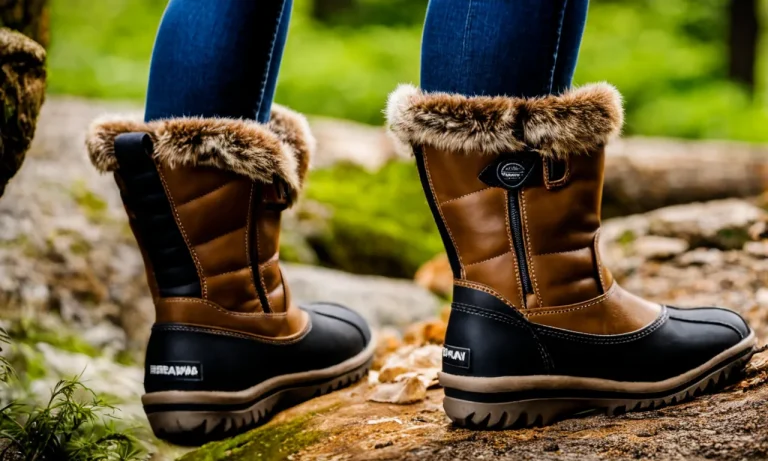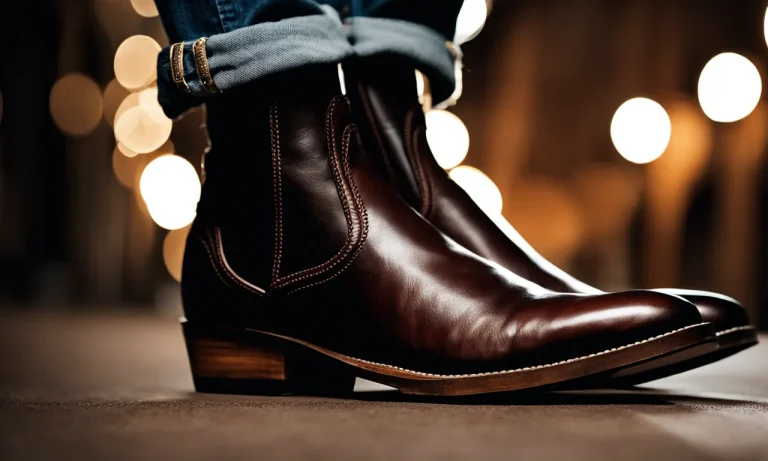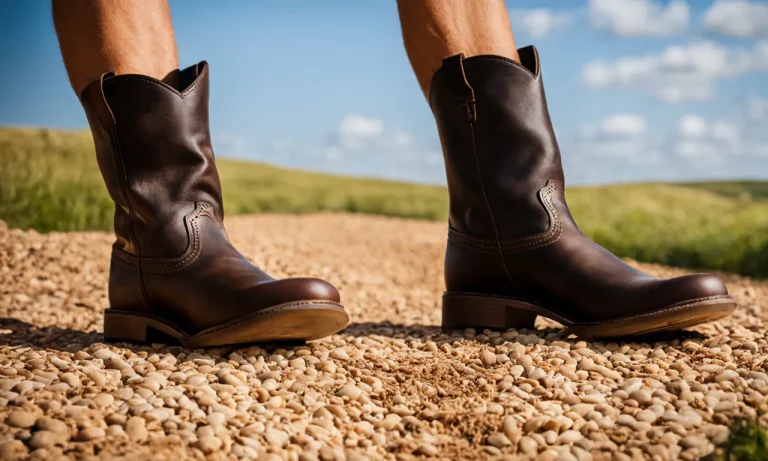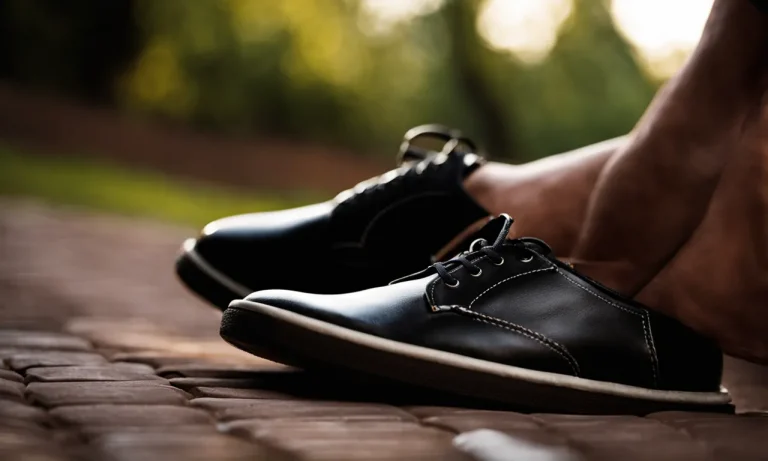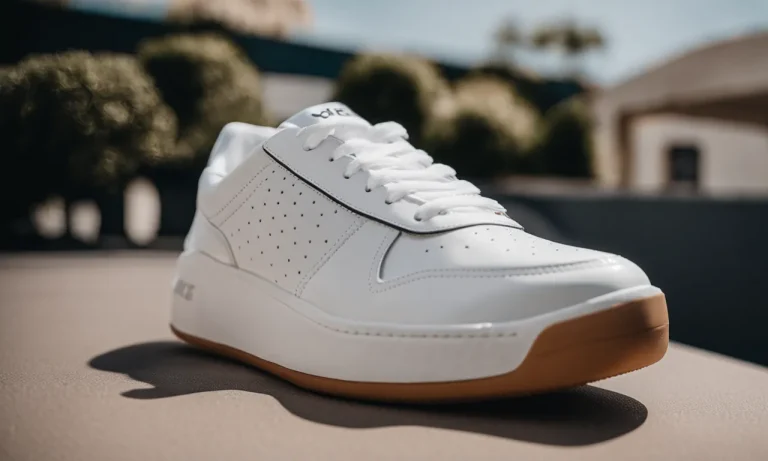If you’ve ever bought a new pair of shoes only to realize one is slightly bigger than the other, you’re not alone. An ill-fitting shoe can cause blisters, calluses, and general discomfort. But before you return them to the store, there are some easy fixes you can try at home.
If you’re short on time, here’s a quick answer to your question: Try tongue pads, heel grips, lacing techniques like the runner’s loop, or even wearing thicker socks on the smaller foot.
Determine Why One Shoe Is Bigger
When you discover that one of your shoes is bigger than the other, it can be frustrating and uncomfortable to wear. However, before you start worrying about having to buy a new pair, there are a few things you can do to determine why one shoe is bigger.
Measure Both Shoes
Start by measuring both of your shoes to see if there is a noticeable difference in size. Use a ruler or measuring tape to measure the length and width of each shoe. If there is a significant difference in measurements, it could be a manufacturing defect or a problem with the sizing.
Pro Tip: If you’re unsure about the accuracy of your measurements, you can visit a shoe store and ask them to measure your shoes for you. They have specialized tools that can provide more precise measurements.
Inspect the Construction
Take a close look at the construction of both shoes to identify any discrepancies. Check the stitching, seams, and overall shape of each shoe. It’s possible that one shoe may have been made slightly larger or stretched more during the manufacturing process.
Pro Tip: If you notice any obvious defects or inconsistencies in the construction of your shoes, contact the manufacturer or the store where you purchased them. They may be able to offer a replacement or a solution to fix the issue.
Consider How You’re Wearing Them
Think about how you’re wearing your shoes and whether any external factors could be causing one shoe to feel larger. Are you wearing thicker socks on one foot? Do you tie the laces tighter on one shoe? These small differences in how you wear your shoes can create the illusion of one shoe being bigger.
Pro Tip: Experiment with different sock thicknesses, lace tightness, or even insoles to see if it makes a difference in how your shoes fit. Sometimes, a simple adjustment can help alleviate the issue.
Remember, if you’ve tried all these steps and still can’t determine why one shoe is bigger, it may be worth consulting with a podiatrist or a shoe specialist. They can provide further insight and recommend solutions tailored to your specific situation.
Adjust the Fit With Inserts and Pads
Having one shoe bigger than the other can be uncomfortable and frustrating. Fortunately, there are simple solutions to fix this issue. By using inserts and pads, you can easily adjust the fit of your shoes and ensure a more comfortable wearing experience.
Try Tongue Pads
If your shoe feels loose around the front or the tongue area, tongue pads can be a great solution. These small, adhesive pads are placed on the tongue of the shoe to provide extra cushioning and fill in any gaps. Tongue pads can help reduce slipping and improve the fit of your shoe.
Use Heel Grips or Pads
If your heel is slipping out of the shoe, heel grips or pads can be a wonderful fix. These sticky pads are placed at the back of the shoe to prevent your foot from sliding forward. They provide additional support and reduce the space between your heel and the shoe, ensuring a snug fit.
Add an Insole
If you need to add more volume to the shoe, insoles can be a great option. Insoles come in various thicknesses and materials, allowing you to customize the fit of your shoe. They provide extra cushioning and support, and can easily be inserted into the shoe to make it feel more snug.
Remember, it’s important to choose the right size and type of inserts or pads for your shoes. You can find these products at shoe stores, pharmacies, or online retailers. It’s always a good idea to try different options and see what works best for you.
Lace the Shoes Differently
Do the Runner’s Loop
If you find that one of your shoes is consistently looser than the other, try doing the runner’s loop lacing method. This technique involves creating an extra loop on each side of the shoe’s tongue, which helps to lock the laces and prevent them from loosening up during activities.
To do the runner’s loop, simply make a loop with the lace on each side, then cross them over each other and feed them through the opposite loop. Pull the laces tight and you’ll notice a secure fit that keeps your shoes snug throughout the day.
Skip Eyelets
When one shoe is bigger than the other, another solution is to skip an eyelet or two on the larger shoe. This will allow you to tighten the laces more on the bigger shoe, compensating for the size difference.
Simply lace your shoes as you normally would, but when you reach the eyelet or eyelets that correspond to the larger shoe, skip them and continue lacing up. This technique can help create a better fit and balance between your feet.
Use the Heel Lock Lacing Method
The heel lock lacing method is especially useful for those with narrow heels or if one shoe tends to slip off more easily than the other. This technique involves creating a loop with the laces near the ankle area and then threading the laces through these loops before tying them.
The loops act as a locking mechanism that holds the heel in place and prevents it from slipping out. By using the heel lock lacing method on the larger shoe, you can ensure a more secure and comfortable fit.
Wear Thicker Socks
One simple solution to fix the problem of one shoe being bigger than the other is to wear thicker socks. Thicker socks can help fill up the extra space in the larger shoe and provide a more snug fit. By adding an extra layer of padding, thicker socks can help prevent your foot from moving around too much inside the shoe.
Benefits of wearing thicker socks
Wearing thicker socks not only helps solve the problem of one shoe being bigger, but it also offers other benefits:
- Improved comfort: Thicker socks provide additional cushioning and can make your shoes feel more comfortable, especially if you’re standing or walking for long periods.
- Better insulation: Thicker socks can help keep your feet warm during colder seasons or in cold environments.
- Reduced friction: Thicker socks can help reduce friction between your foot and the shoe, preventing blisters and discomfort.
Tips for choosing the right thickness
When selecting thicker socks, consider the following:
- Material: Look for socks made from materials such as wool or cotton blends, as they tend to be thicker and provide better insulation.
- Fitting: Ensure that the socks are not too tight or too loose, as this can affect your overall comfort.
- Activity level: If you engage in high-intensity activities or sports, choose thicker socks with extra padding in the areas that need it the most, such as the heels and toes.
Remember, wearing thicker socks is a temporary solution and may not completely fix the issue. If the difference in size between your shoes is significant, it’s advisable to consult a professional shoe repair person or a podiatrist for a more permanent solution.
Use Shoe Stretchers
What Are Shoe Stretchers?
If you have one shoe that is slightly bigger than the other, using a shoe stretcher can be an effective solution. Shoe stretchers are tools designed to expand the width or length of a shoe. They are typically made of wood or plastic and come in various sizes to accommodate different shoe sizes.
Shoe stretchers work by applying gentle pressure to the areas of the shoe that need stretching, allowing the material to gradually expand and conform to the desired shape.
It’s important to note that shoe stretchers are not suitable for all types of shoes. They work best with leather or fabric shoes that have some flexibility. Hard materials like plastic or metal may not respond well to stretching and could potentially be damaged.
Shoe stretchers can be purchased online or at shoe repair shops. It’s a good idea to invest in a high-quality stretcher to ensure durability and effectiveness.
How to Use Them
Using a shoe stretcher is a relatively simple process. Here’s a step-by-step guide:
- Start by inserting the shoe stretcher into the shoe that is larger.
- Adjust the stretcher to the desired width or length by turning the knob or handle. Be cautious not to over-stretch the shoe, as it may lead to deformation.
- Leave the stretcher in place for at least 24 hours to allow the material to adjust and stretch.
- Try on the shoe and assess the fit. If it still feels tight, repeat the process with the stretcher set at a slightly higher level.
- Once you are satisfied with the fit, remove the stretcher from the shoe.
It’s important to be patient when using a shoe stretcher, as the stretching process takes time. Rushing the process could potentially damage the shoe or cause discomfort when wearing them.
If you’re unsure about using a shoe stretcher, it’s always a good idea to consult a professional shoe repair person. They can provide guidance on the best method to fix your specific shoe sizing issue.
Conclusion
Having one shoe that’s slightly bigger than the other can be annoying, but it doesn’t mean you have to get rid of them. With some simple adjustments like tongue pads, heel grips, adjusting your lacing, or wearing thicker socks, you can make that pair fit comfortably.
Give some of these tips a try before deciding to return or replace your shoes.

